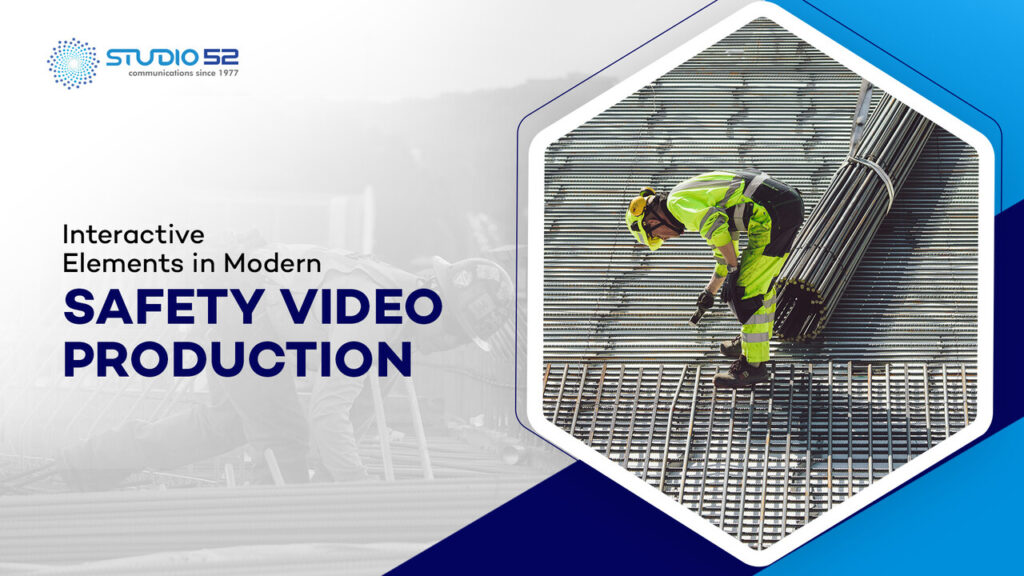In today’s fast-paced industries, traditional safety training methods, such as printed manuals and lengthy lectures, are no longer enough to meet the demands of modern workplaces. At Studio52 health and safety video production company, we understand the need for innovative solutions, which is why we specialise in modern safety video production that leverages interactivity to transform passive learning into dynamic, engaging experiences.
This shift is especially critical in high-risk industries such as construction, oil & gas, and manufacturing, where effective safety training not only saves lives but also prevents costly accidents. By blending cutting-edge technology with creative storytelling, interactive safety videos capture attention, enhance understanding, and improve retention of critical safety protocols.
We’re committed to helping businesses reshape workplace safety standards and empower employees with the tools they need to succeed. Today, we’re making safety training smarter, more effective, and more engaging than ever before. Enhance workplace safety with engaging safety videos—discover the science of engagement safety videos.
In this blog, our experts have shared key elements that will help you on your journey to creating better safety videos.
Table of Content
Types of Interactive Elements in Workplace Safety Training Videos
Interactive safety videos go beyond traditional training methods by incorporating engaging features that enhance comprehension, retention, and real-world application. A good industrial safety video production company cannot claim expertise without implementing any of the interactive elements.
Here are the most impactful interactive elements used in modern, professional health & safety and training videos:
1. Clickable Hotspots for In-Depth Learning
Clickable hotspots transform safety videos into an interactive learning experience, allowing employees to engage directly with specific areas of the screen for more detailed information. These hotspots provide:
- Additional explanations about machinery, tools, or safety procedures.
- Step-by-step instructions on handling hazardous materials or operating complex equipment.
- Links to company policies, emergency protocols, or external safety guidelines.
Example: A construction site training video could feature clickable zones on heavy equipment, allowing employees to explore proper usage techniques, potential hazards, and required protective gear.
2. Quizzes and Assessments for Knowledge Retention
Built-in quizzes and knowledge checks help reinforce key safety concepts, ensuring that employees fully understand the material before advancing. These assessments provide:
- Instant feedback to highlight areas that need improvement.
- A measurable way to track progress and comprehension.
- Certification opportunities, validating employees’ readiness for the job.
Example: In a manufacturing safety training module, employees may watch a segment on machine lockout procedures and then complete a quiz to test their understanding before proceeding.
3. Scenario-Based Training for Real-World Decision-Making
Scenario-based training immerses employees in realistic workplace situations, requiring them to make choices and experience the outcomes of their decisions. These interactive scenarios:
- Mimic real-life safety challenges, helping employees develop critical thinking skills.
- Demonstrate the consequences of improper safety practices in a controlled environment.
- Offer multiple response options, reinforcing correct actions through guided learning.
Example: An oil refinery worker might engage in a virtual emergency drill where they must choose between different evacuation routes in response to a simulated fire. Their decision-making process is evaluated to ensure proper emergency response training.
4. Personalised Learning Paths for Role-Specific Training
Not all employees require the same level of safety training. Personalised learning paths allow employees to select training modules relevant to their specific job roles, ensuring more effective learning. Benefits include:
- A customised experience tailored to job responsibilities.
- Higher engagement by eliminating irrelevant content.
- Flexibility to revisit sections as needed.
Example: A factory setting may offer customised safety training for different roles – machine operators receive instructions on equipment handling, while maintenance staff focus on electrical safety and emergency shutdowns.
5. Augmented Reality (AR) Integration for Immersive Training
Augmented reality (AR) enhances traditional video content by overlaying interactive digital elements onto real-world environments. This cutting-edge technology:
- Provides hands-on, interactive learning without physical risk.
- Allows employees to visualise complex safety protocols in real-time.
- Creates an engaging and memorable training experience.
Example: AR-enhanced safety videos can guide workers through equipment assembly by projecting interactive step-by-step instructions onto the actual machinery, ensuring correct and safe usage.
6. Interactive Infographics for Visual Data Representation
Safety training often involves complex data, such as injury statistics, evacuation routes, and hazard classifications. Interactive infographics simplify these details, making them more digestible and engaging. Benefits include:
- Clear and concise visualisation of safety data.
- Easy navigation through various sections of a safety plan.
- Animated transitions that highlight key points dynamically.
Example: A construction site safety video might include an interactive infographic showing accident statistics over time, demonstrating how improved safety measures have reduced incidents.
At Studio52 safety training video production company, we take pride in creating cutting-edge safety training videos that incorporate these interactive elements to maximise engagement and retention. Let us help you revolutionise your workplace safety training with innovative video solutions tailored to your industry’s needs.
Benefits of Interactive Safety Videos
Interactive safety videos have revolutionised traditional training methods by incorporating dynamic elements that actively engage employees, leading to more effective learning experiences. The key benefits of these interactive videos include:
1. Increased Engagement
Traditional safety training methods, such as printed manuals and lengthy lectures, often result in passive learning, where employees may struggle to maintain focus. Interactive safety videos incorporate elements like clickable hotspots, quizzes, and scenario-based simulations that require active participation.
This active involvement keeps employees engaged, reducing the likelihood of viewer fatigue and enhancing the overall learning experience. Research has shown that active learning strategies can significantly boost student engagement and knowledge retention.
2. Improved Retention
Engaging with interactive content allows employees to better internalise safety protocols. Studies have indicated that interactive learning can increase retention rates by up to 75%, as it encourages learners to actively process information rather than passively receive it. This heightened retention ensures that critical safety procedures are more likely to be remembered and applied in real-world situations.
3. Personalised Learning
Interactive safety videos can be tailored to address the specific needs of different roles within an organisation. By customising content to align with individual responsibilities, employees receive training that is directly relevant to their daily tasks. This targeted approach not only saves time but also enhances the effectiveness of the training, as employees can focus on the safety protocols most pertinent to their roles.
4. Enhanced Application
Through scenario-based training and simulations, interactive videos bridge the gap between theoretical knowledge and practical application. Employees can practice safety procedures in a controlled, virtual environment, allowing them to experience the consequences of their decisions without real-world risks. This experiential learning prepares workers to handle actual safety challenges more effectively.
5. Data Collection and Insights
Interactive safety videos often include built-in assessments and tracking features that monitor employee progress. By analysing quiz results and interaction patterns, managers can identify areas where employees may struggle or lack understanding. These insights enable targeted follow-up training, ensuring that the workforce is well-prepared and compliant with safety standards.
Interactive safety videos implementing interactive elements not only capture attention but also foster better understanding and retention of critical safety protocols. By blending technology with creativity, these videos are gradually reshaping workplace safety standards and boosting employee preparedness.
Maximize workplace safety with the impact of safety training videos—discover how Studio52 enhances safety awareness
Industry Use Cases for Interactive Safety Videos
1. Construction
- Interactive safety videos are widely used to demonstrate proper handling of tools, machinery, and hazardous materials.
- Example: A time lapse video of a construction site combined with hotspots can educate workers about restricted zones or equipment handling.
2. Oil & Gas
- Safety training in oil & gas often involves high-risk scenarios like fire hazards or equipment failures.
- Example: Scenario-based videos simulate emergency situations, allowing workers to practice critical decision-making.
Ensure a safer workplace in the Saudi oil & gas industry with safety video solutions from Studio52,
3. Manufacturing
- Manufacturing facilities use interactive videos to teach employees about equipment operation, maintenance, and accident prevention.
- Example: AR integration can show real-time instructions for operating machinery or wearing protective gear.
Conclusion
Interactive safety videos have revolutionised workplace training by transforming static, one-size-fits-all content into dynamic, engaging learning experiences. These videos foster better retention, enhance safety awareness, and empower employees to respond effectively in high-risk situations.
For industries like construction, oil & gas, and manufacturing, interactive safety videos are not just an upgrade but a necessity for improving worker safety and compliance.
At Studio52, we specialise in producing professional health and safety training videos tailored to your industry’s unique needs. Whether it’s integrating interactive elements, creating scenario-based training, or incorporating AR technology, our team of safety training video production experts is here to create the best safety videos for UAE workplace safety.
Upgrade your workplace safety standards with interactive safety videos that engage, inform, and protect your workforce. Contact us today to explore how our health and safety video production services can transform your training program.



